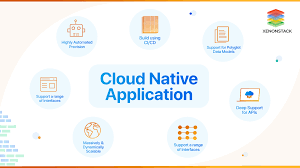When starting to work with cloud providers, you will encounter questions similar to whether should you use Cloud Native or Cloud Agnostic architecture to set up the application. Before making any decisions, you need to understand both options.
The Differences Between Cloud Agnostic Vs Cloud Native will help you understand their differences.
Contents
What is Cloud Agnostic?
Cloud Agnostic refers to applications and workloads that can be seamlessly moved between cloud platforms without being constrained by operating conditions. Cloud-agnostic tools can work on any cloud provider or platform. They also work well on Google, AWS, or Microsoft Azure, which means it’s fairly easy to migrate without interruption. No matter what activity takes place you get the same results because the tools do not rely on the basic customization features of a particular platform. Additionally, it offers companies the opportunity for scalability and flexibility, along with customization options to meet specific business requirements.
Pros of Cloud Agnostic
Unlimited portability: Programs are platform-independent, so they can be moved anywhere in the storage space.
Consistent performance: Businesses can take advantage of more features and options to maximize system performance.
Avoid being locked out: Portability also translates into freedom from cloud service providers. Those are the people who can change the terms or conditions of operation.
Cons of Cloud Agnostic
High upfront capital costs: Although cloud-agnostic tools have the potential to save you money over time. However, you may face higher upfront costs while developing and deploying the application. In many cases, you won’t be using out-of-the-box tools because you’ll want to take advantage of the system’s unique features. That means spending time and money on a development team.
Cloud agnostic applications may not take advantage of all platform features: There are advantages to using specific cloud platforms. However many cloud platforms are built to excel in specific areas of use.
What is Cloud-Native?

In theory, Cloud native is an approach to building and running applications that exploit the advantages of the cloud computing model. It implies that applications are built in Public Cloud infrastructure instead of built on traditional data centers. One of the big mistakes customers make is trying to upgrade and migrate legacy applications to the cloud. Instead, customers should bring Cloud native applications to the new cloud infrastructure. Or subdivide existing monoliths to refactor them using cloud-native principles from scratch.
You also need to reorganize your old developer methods. The waterfall model certainly won’t do. So you have to adopt new Cloud-native approaches like MVP product development, and multivariate testing.
As the name suggests, it helps build and run applications by leveraging services and components tied to the Cloud Service Provider itself. For example, use CloudWatch for service monitoring with AWS, and Azure Monitoring Service for Azure.
Cloud-based development can work with both public and private clouds. Additionally, it provides the development team with access to advanced computing power along with state-of-the-art data and application services. Furthermore, it makes it easy to integrate DevOps and other cloud components like microservices and containers.
Pros of cloud-native
Scalability: Easily expand or shrink the system to meet your business needs.
Resilience: Microservices in a cloud-based environment enable resiliency. Smaller component failures also won’t affect the entire ecosystem.
Performance: Focusing on a small segment of each component allows for an increase in the performance of the entire system in use.
Cons of cloud-native
Carrier lockout and limited flexibility for system development: If you’ve committed too much to a previous platform or tool, you may find yourself limited by your current vendor lockout. Although hyper-scale cloud providers offer platforms that are full-featured and easy to use. However, they often have a much higher locking and operating overhead. Native cloud computing is ultimately allowing you to take advantage of hyper-scale cloud providers while maintaining the ability to consider hybrid multi-cloud and cloud architectures.
Network-wide Data Management & Security: With so many tiny moving parts, security, data loss prevention, and network communication between these services are complex and difficult.
Monitoring & Management Challenges: Microservices micromanagement requirements.
Difference between Cloud Agnostic Vs Cloud Native
1. Costs
Proprietary cloud service providers (CSPs) typically charge enterprise customers based on a combination of licensing and data storage requirements. Allows organizations to follow a pay-as-you-go model instead of paying a flat-rate subscription fee. In addition, CSPs such as AWS, Azure, and Oracle provides dedicated cloud cost management services that help organizations effectively control cloud spending.
However, with a cloud-agnostic approach, businesses have to do it themselves. Since the cloud-agnostic architecture is more accessible to open-source tools, some argue that it provides more direct control over cost and capacity. Make spending adjustments as needed. However, this requires organizations to carefully monitor spending to ensure that money is not wasted on platform tools or services that the development team does not use. Also, the organization is responsible for the cost of recovering from major application failures which can amount to a huge bill.
2. Flexibility
Cloud-based approaches often offer more flexibility in the development process than cloud-based approaches. This is because of the cloud-agnostic architecture, developers are not restricted to the capabilities or tools of a proprietary cloud platform. Additionally, cloud-agnostic architectures often incorporate tools, libraries, and open source that are constantly evolving to reflect emerging development trends.
On the other hand, cloud-native applications can benefit from the built-in provisions of the proprietary platform. Those include security, networking, monitoring, and other architectural concerns that tend to hinder enterprise growth efforts. AWS CodeCommit and CodePipeline are a few examples of powerful toolsets that can only be used by platform subscribers.
It’s also important to note that automation and DevOps platforms like Jenkins and Gitlab provide a viable level of support for standalone, non-cloud builds of apps. However, not trusting the cloud will inevitably require developers to create and integrate functions themselves, which can be an expensive and time-consuming process that requires in-house expertise.
3. Time to market

A cloud-based strategy will typically allow a shorter time to market for an app build than a cloud-based strategy. Thanks to the array of pre-built templates, tools, and ready-to-use infrastructure that most vendors include in their proprietary platforms. The Cloud Build service in Google Cloud Platform, for example, allows developers to build, deploy, and test applications instantly. Even provides a streamlined system for rapid deployment across multiple clouds.
The complexity of adapting a cloud-agnostic architecture to take on new applications and features means it can take some time for projects to start rolling out. Because of this, organizations may be at risk of losing their competitive edge in operations.
4. Scalability
Cloud-agnostic architecture is arguably the better choice when it comes to the scalability of enterprise applications and services. This is because, in a non-cloud architecture, applications and services can migrate across cloud platforms. This means they can quickly scale to meet the operational needs of the business.
This is especially useful when migrating on-premises architecture to the cloud. Because having a platform or cloud-agnostic architecture makes the transition easier while keeping core business services on-premises. Open source tools like Helm chart for resource generation or Prometheus for monitoring. They work the same no matter which cloud platform they are used on.
5. Effective
The cloud-native architecture makes the most of CSP tools, and the cost of those tools will include support for things like security enforcement, back-end management, and continuous application monitoring. With a cloud-based approach, on the other hand, you can pay for tools you never use in the business.
There can also be orchestration challenges related to cloud agnostic architecture, of which applications running on several platforms are an example.
6. Reliability
Developing applications and services to work in any production environment, as is the case with cloud-agnostic architectures, can provide good redundancy and rapid recovery in case of an error. To further minimize downtime, you can move the service to another platform while it’s under maintenance or experiencing an outage.
Cloud-based strategies, on the other hand, often run the risk of vendor lock-in. If a CSP decides to raise prices or discontinue its services, businesses with a cloud-based architecture could be thrown into disarray.
Cloud-based and cloud-based approaches are not mutually exclusive, and you don’t have to go all out when choosing a strategy. Technically, each method can be used for different business groups with unique needs. Hope the article The Differences Between Cloud Agnostic Vs Cloud Native will be useful for you.


